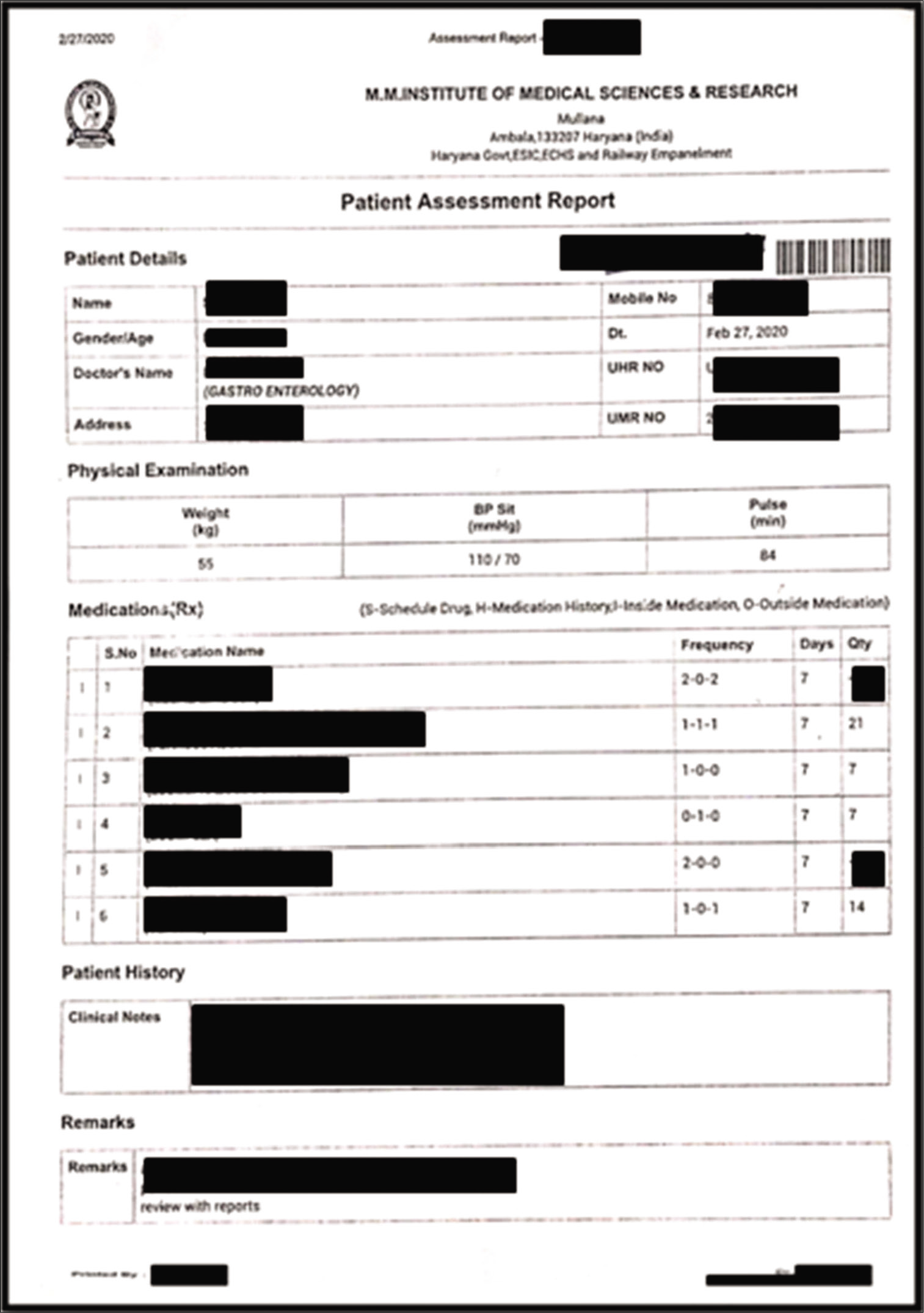Translate this page into:
E-prescription – Curbing the COVID-19!

*Corresponding author: Amit Soni, Department of Gastroenterology, Maharishi Markandeshwar Institute of Medical Sciences and Research, Maharishi Markandeshwar (Deemed To Be) University, Ambala -133207, Haryana, India. aamitsoni@gmail.com
-
Received: ,
Accepted: ,
How to cite this article: Soni A, Nagpal S, Mittal A. E-prescription – Curbing the COVID-19! Indian J Med Sci 2020;72(2):119-21.
Dear Editor,
Within a couple of months since the first case diagnosis, coronavirus disease 2019 (COVID-19) briskly swamped the world and was affirmed as the pandemic by the World Health Organization.[1] The primary source of contagion remains the respiratory droplets and infected fomites. With more than 200 countries (including areas/territories) afflicted, 7.5 million confirmed cases and 400 thousand deaths, the rising figures are disquieting.[2] India is currently combating this pandemic with full vigor. A nationwide lockdown was implemented in India from March 25, 2020, when there were nearly 600 cases diagnosed with COVID-19 in the country. There was no community transmission of COVID-19 in India and it was struggling hard to contain the disease, with 46,000 confirmed cases till the 1st week of May.[2] However, by the mid of June 2020, the total cases in India have crossed 3 lakhs and total deaths are nearing 10000.[3]
Health care workers being the first line warriors against this viral ailment, are at a very high risk to be afflicted with it. Once the lockdown is called off in India, the outpatient clinics will a fresh start operating in full swing. One cannot deny that the big trouble that doctors are anticipating is that many asymptomatic COVID-19 patients will come for consultation of their previous comorbidities (non-COVID-related chronic issues). During the period of minimal symptoms, high titer of virus has been detected in oropharynx suggesting increases infectivity at that time.[4] Medical professionals are very vigilant and will be cautious during the outpatient clinics to practice social distancing, use of needful personal protective equipment (PPE), hand hygiene and limited patient examination as per the requirement, etc. However, among many things, one thing which can also probably jeopardize the doctor’s safety is the patient record file.
The patient record file, in usual scenario, contains numerous past prescriptions, laboratory reports, radiological films, and plastic file. This is one thing which will be relocated from patient’s hand (a potential COVID-19 carrier) to the doctor’s desk and hence breach the social distancing. This becomes more important in the Indian scenario, wherein personal hygiene and cough etiquettes lack to an extent among patients. It is not an uncommon scene to find patients openly coughing in the outpatient clinic area or in worst scenario using their record file to cover the mouth instead of using a mask/cloth. Experimental studies have shown that various viruses remain alive on paper and plastic for few to several hours.[5] The exact behavior of coronavirus (COVID-19) on various fomites demands additional evidences to decipher it.
In India, a substantial number of hospitals and health care institutions are maintaining their inpatients record in electronic form. Nonetheless, only a lean number of establishments have electronic prescription (e prescription) for outpatient clinics. In our institute, we started using an electronic prescription [Figure 1] in our outpatient clinics almost a year back. The electronic prescription of a particular patient is sent to the pharmacy section and patient gets his copy of e-prescription and medicine from the pharmacy. All previous OPD visit details including the clinical notes, prescribed medicines, and laboratory investigations are ever available for a second look. Hence, a patient with chronic illness (with a bundle of documents) when visits for follow up, does not get any of his preceding records as the details are available in electronic form in outpatient clinic. This indeed upholds the needed social distancing.

- A picture of electronic prescription currently being used in the institution.
There are few limitations too. First, the doctor will have to go through the past records of a patient who visits the clinic for the first consultation, thus obviating the leverage of an E- prescription. However, if the vital records are added to the data during primary visit, the subsequent visits will not jeopardize the health worker safety. Second, while the gain will be long lasting, installing this technology during the pandemic might not be a straight forward task. At present, the hospital management is engaged with multiple assignments, the most critical being the upgradation of existing facilities to treat COVID-positive patients. On the contrary, it will be simple and prompt to start in hospitals where this amenity exists but was being underutilized. Finally, as with any software, it is liable to malfunction, virus and hacking threats, etc. Hence, one needs to follow the recommended protocols and preventive measures. The main challenge that low- and middle-income countries will face in generating e-prescription is the cost. However, as far as expenditure is concerned, this does not need a big one because computers and IT (Information and Technology) maintenance department preexists in majority of hospitals. Even if cost is an issue at places, the hassle free long-term sustenance overshadows it.
This COVID-19 pandemic has changed the perspective of researchers, policy-makers, and medical communities globally. As predicted by the experts, telemedicine will come as a savior to many during this pandemic, giving leverage to those who invested in it.[6] Wizards suggest that during this era, one has to swiftly accept and adjust to the numerous changes that are happening to build up the new normal. In times to come, health care institutions in low- and middle-income countries should also replace the existing paper prescriptions to e-prescriptions in outpatient clinic. E-prescription, apart from its conventional benefits like lower drug errors, better data maintenance, etc., will also be considered as one of the armamentarium (not to forget PPE, hand hygiene and social distancing, etc.) to prevent against the contagious diseases, wherein fomites play a pivotal role. It is prudent that one should harness the technological advances to get maximal gain and E-prescription is one of them.
Declaration of patient consent
Patient’s consent not required as there are no patients in this study.
Financial support and sponsorship
Nil.
Conflicts of interest
There are no conflicts of interest.
References
- WHO Announces COVID-19 Outbreak a Pandemic. 2020. Geneva: World Health Organization; Available from: http://www.euro.who.int/en/health-topics/health-emergencies/coronavirus-covid-19/news/news/2020/3/who-announces-covid-19-outbreak-a-pandemic [Last accessed on 2020 Apr 20]
- [Google Scholar]
- Coronavirus. 2020. Available from: https://www.who.int/emergencies/diseases/novel-coronavirus-2019 [Last accessed on 2020 Jun 16]
- [Google Scholar]
- MoHFW Home. 2020. Available from: https://www.mohfw.gov.in [Last accessed on 2020 Jun 16]
- [Google Scholar]
- SARS-CoV-2 viral load in upper respiratory specimens of infected patients. N Engl J Med. 2020;382:1177-9.
- [CrossRef] [PubMed] [Google Scholar]
- Significance of fomites in the spread of respiratory and enteric viral disease. Appl Environ Microbiol. 2007;73:1687-96.
- [CrossRef] [PubMed] [Google Scholar]
- Virtually perfect? Telemedicine for COVID-19. N Engl J Med. 2020;382:1679-81.
- [CrossRef] [PubMed] [Google Scholar]





